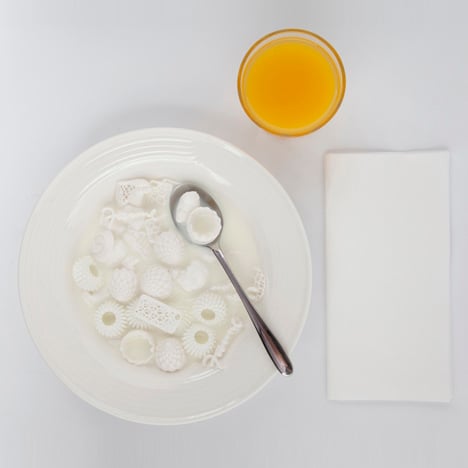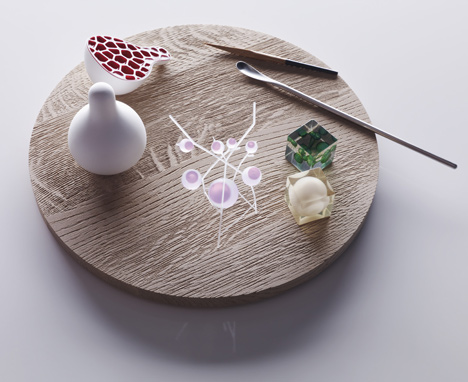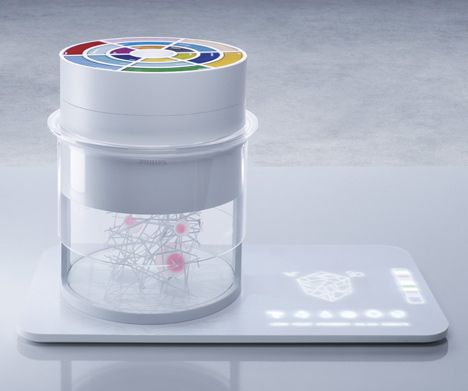
"One day we will be able to 3D-print a hamburger"
In this article from Print Shift, our one-off magazine about additive manufacturing, Dezeen's Ben Hobson asks how soon we could be tucking into 3D-printed steaks.
The concept of 3D-printed food is hard to swallow, but technology that could revolutionise the way we cook is hotting up.
In 2009, Philips Design presented a sci-fi vision of the future with a conceptual food printer that could produce a perfectly balanced meal at the touch of a few buttons. Part of a research project called Food Probe, which looked at how we might source and eat food in 15 to 20 years’ time, the imagined machine would allow our future selves to print out our ideal combinations of flavours and nutrients in an unlimited range of forms.
It sounded too Star Trek to be true (as Dezeen readers were quick to point out when we originally ran the story). But with 3D-printing technologies advancing as rapidly as they are, the idea may not be as far off as it once seemed.

Philips itself is not developing a 3D food printer, but companies around the world are starting to take the concept seriously. Janne Kyttanen has been at the forefront of 3D-printing technology for many years and he believes food is next on the list to be revolutionised by 3D printing. "We have many different avenues in which 3D printing technology is moving. We’ve explored all different kinds of products and different materials," he says. "Food is the next frontier."
Kyttanen has already 3D-printed an experimental hamburger and a breakfast cereal in novelty shapes, including his own head, but these are merely conceptual models of plastic and plaster. "I wanted to pinch people a little bit. I printed burgers just to create an iconic image and make people realise that one day we will be able to 3D-print a hamburger."
But while the 3D-printed burger of the future is some way off, the transition from printing with plastics to printing with food has already begun. In 2011 Luis Fraguada, research director at architecture studio Built By Associative Data, was using a desktop 3D printer to produce prototypes of customised crockery when he was approached by a young chef called Paco Morales, who asked him a question: if you can print out a plate, could you also print out a piece of food onto that plate?
Fraguada and Morales, together with architects Deniz Manisali, José Ramón Tramoyeres and Andrés Arias Madrid – who collectively make up the research group Robots In Gastronomy – have been working on a 3D food printer ever since.
Their machine uses an adapted version of the same fused deposition modelling technology that’s commonly used to print plastics: food is extruded through a nozzle and built up in layers to the specified design. "We started with a MakerBot," Fraguada explains. "We put in our own print head to let us print out viscose food materials."
The nature of the technology means the printer is limited to creating customised 3D shapes out of soft or puréed foodstuffs such as mascarpone, guacamole or chocolate spread; Fraguada soon discovered that "Nutella is the perfect material for printing". But he believes the potential for the technology extends far beyond simple novelty value.
"For me, it’s interesting to think about the possibilities for somebody with specific dietary requirements – someone who needs to precisely measure out certain types of food, for example. Nutrition is the root of many of our medical problems, globally. My hope is that at some point we will have more control over the elements that we put into our bodies."
It’s not just designers who are exploring the possibilities of 3D-printed food. Scientists at Cornell University’s Creative Machines Lab in Ithaca, New York, have developed an open-source desktop 3D printer called Fab@Home, which, using a similar extrusion-based technology, can print with plastic as well as cake mixture, icing and peanut butter.
They have also experimented with meat, but that proved to be much trickier. "We know from the flavouring industry that we can make anything taste like anything, and we know from the colouring industry that we can make anything look like anything," Cornell scientist Jeffrey Lipton says. "But if food doesn’t have the right feel to it, if it feels too processed, people have a gut reaction against it."
Nobody wants to eat a gloopy steak, basically. But Lipton has enjoyed some success with using meat as a print material. In 2010 he was able to print various types of puréed meat into shapes that were then deep-fried, including a scallop printed into the shape of a space shuttle, which was, Lipton assures, "absolutely delicious". The key was to combine the puréed meat with an enzyme called transglutaminase, which helps the proteins reconnect and the meat to regain its texture. Lipton believes that with the necessary scientific research, we will one day be able to take the next step and print foodstuffs like meat "from the ground up".

In fact, the research is already well underway. American company Modern Meadow was set up in 2012 with the specific goal to develop in vitro meat and leather products for which no animal has to die. The idea is to use the same bioprinting technology that is being developed in the medical industry to grow transplantable human tissue, but to produce meat for human consumption instead.
Modern Meadow is still a development-stage company, and it has put no time frame on when the meat it hopes to produce will be available to buy. But it has the money behind it to succeed; PayPal co-founder and billionaire Peter Thiel is an investor.
There are others willing to put money behind 3D-printed food. Kjeld van Bommel is a research scientist at Dutch contract research organisation TNO, which works with some of the world’s biggest food companies, and he says they are interested. "We’re actually doing projects with some international companies, big food companies, that see a future for 3D-printed food," he says.
Unfortunately these projects are all top secret. But there is one project van Bommel is free to discuss. TNO is helping to develop a food printer as part of an EU-backed project aiming to improve the lives of people suffering from a condition called dysphagia, which causes chewing and swallowing problems. By removing the usual pleasures of eating, the condition often leads to malnutrition.
The machine TNO is developing will combine puréed foodstuffs with a special gelatine binding agent, and print them out in 3D shapes that are soft enough to be eaten. "We’re going to print a piece of chicken and we’re going to print a potato," van Bommel explains. "People will get a plate of food in front of them that they can eat with a knife and fork, rather than having a milkshake three times a day. It’s already been shown that people eat better when they do that."
The printer will work much like a 2D inkjet, printing out food in droplets and building up a 3D structure layer by layer. Crucially, just like the food printer conceived by Philips Design, its output will be completely customisable. "The food will be personalised," van Bommel enthuses. "The number of calories will be personalised. Nutrients like calcium or omega-3 fatty acids will be personalised as well. Even the softness or hardness of the food will be tuned to the needs of the client. Everyone will get their own personalised plate of food in front of them."
This printer is not a far-off fantasy. The project started in 2012, and if it stays on schedule, they’ll have a working prototype within three years. Van Bommel believes it will only take another couple of years after that before a commercial product is available.
Of course, while the softness of the food it will produce has obvious benefits for those suffering from swallowing disorders, most people would not want to eat it.
Nevertheless, as the technology continues to advance, and with companies with the necessary financial muscle starting to get behind 3D-printed food, a food printer of the kind Philips Design imagined seems a significant step closer to becoming reality.